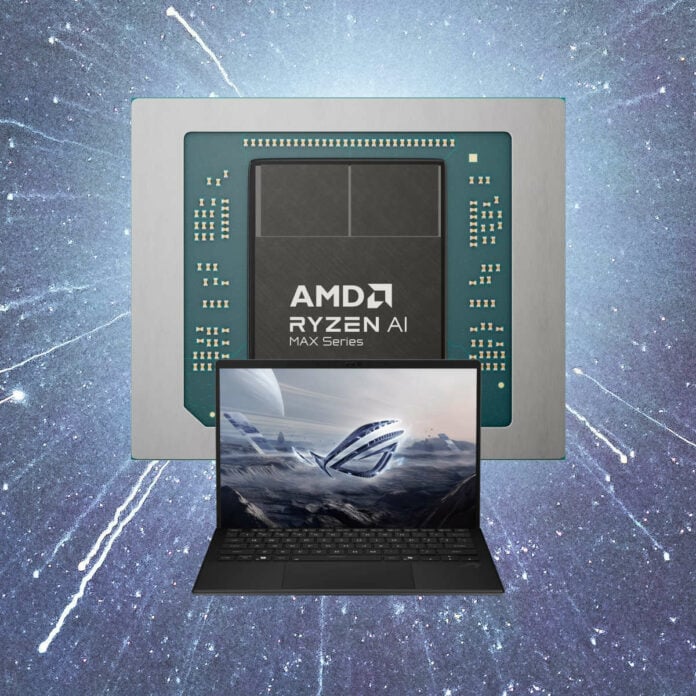Following their announcement at CES 2025, the first reviews of devices rocking Ryzen AI Max 300 Series processors have landed. These are the very best chips AMD has to offer mobile devices, and their performance is remarkably strong relative to competitors new and old. Team Red has Apple in its sights with these SKUs and it might just have cracked the code in competing with the tech giant’s M Series silicon in many respects.
Ryzen AI Max 300 Series packs up to 16 Zen 5 cores and XDNA 2 NPUs cable of performing up to 50 TOPS. The main attraction here though is the 40 RDNA 3.5 compute units which blow away competing integrated graphics solutions. To put the enormity of this GPU die into perspective, AMD’s fastest solution prior to this one, Radeon 890M, boasted a mere 16 RDNA 3.5 compute units.
AMD adopted a chiplet design with Ryzen AI Max 300 Series, as it did with its Radeon RX 7000 Series graphics cards. This essentially allows the company to pack individual chip components more densely, varying process nodes where appropriate to save on cost. There’s no integrated memory here unlike Lunar Lake competition but the processors can support up to 128GB of LPDDR5X.
When it comes to power consumption, AMD allows partners to customise Ryzen AI Max 300 Series as they see fit with a TDP range of 45-120W. This should allow manufacturers to cater the processors to their device’s needs or cooling capabilities but it will lead some performance variances. For instance, Asus configures Ryzen AI Max+ 395 to run at 70W in ROG Flow Z13 (2025), a 2-in-1 laptop that is just 14.9mm thin.
Thanks to its massive GPU, the high-end Ryzen AI Max+ 395 practically eliminates the need for separate dedicated graphics. For example, Hardware Canucks show the GPU pushing 50fps in Calisto Protocol, 53fps in Red Dead Redemption 2, and 150fps in Doom Eternal at 1600p highest settings. Even more-demanding games maintain playable frame rates with Cyberpunk 2077 holding 39fps. Reducing resolution to 1080p saw frame rates jump to around 70fps, transforming the gaming experience.
This becomes all the more impressive when you compare Ryzen AI Max+ 395 to the likes of GeForce RTX 4070 in a laptop. Not only was AMD’s chip able to beat Nvidia’s graphics solution at times, it did so while consuming far less power. To put a hat on it, RTX 4070 alone consumed nearly as much power as the entire SoC.
Other reviews have also found impressive performance figures, with Dave2D witnessing 69fps in Space Marine 2, 121fps in Black Ops 6, and 99fps in Cyberpunk 2077 at 1080p medium settings. As for the folks at NotebookCheck, they found 85fps in Baldur’s Gate 3, 142fps in Dota 2, and 75fps in Cyberpunk 2077 at 1080p Ultra.
Awesome as Ryzen AI Max 300 Series graphics performance is, its compute abilities shine too. Ryzen AI Max+ 395′ manages to surpass Apple M4 Pro by 26% in Cinebench R23, despite conceding ground in the newer 2024 version of the application. Moving to Blender, Houdini, and Handbrake, the Ryzen marked small wins against the M4 Pro, showing its multi-threaded strength, albeit while consuming more power than Apple’s silicon.
That said, even when limiting power to 50W, Ryzen AI Max+ 395 maintains respectable performance, giving the M4 Pro a run for its money. When factoring in Apple’s full control over the entire stack from hardware development to software optimisation, AMD’s chip is quite impressive.
Reading over these results makes me excited for the future of mobile computing. This will undoubtedly have knock-on effects for handheld gaming devices, once AMD can bring power consumption down a peg or two. In the meantime, there’s Z2 Extreme to look forward to in addition to the presumably large number of devices that will rock Ryzen AI Max 300 Series processors.

